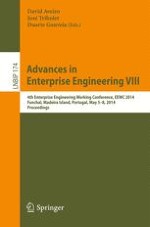This book constitutes the proceedings of the 4th Enterprise Engineering Working Conference (EEWC), held in Funchal, Madeira Island, Portugal, during May 5-8, 2014. EEWC aims at addressing the challenges that modern and complex enterprises are facing in a rapidly changing world. The participants of the working conference share a belief that dealing with these challenges requires rigorous and scientific solutions, focusing on the design and engineering of enterprises. The goal of EEWC is to stimulate interaction between the different stakeholders, scientists, as well as practitioners, interested in making enterprise engineering a reality.
The 13 papers presented were carefully reviewed and selected for inclusion in the book. EEWC 2014 had 42 submissions and accepted 13 for publication. The topics of the presented papers allowed for active participation in interesting discussions and exchange of ideas and stimulated future cooperation among the participants. This made EEWC a real “working conference” contributing to the further development of enterprise engineering as a mature discipline. Topics covered include: enterprise engineering in general, the DEMO methodology, the REA ontology, financial applications, business processes management and enterprise simulation.
